
About UsThe Numismatic Bibliomania Society is a non-profit organization promoting numismatic literature. For more information please see our web site at coinbooks.org SubscriptionsThose wishing to become new E-Sylum subscribers (or wishing to Unsubscribe) can go to the following web page link MembershipThere is a membership application available on the web site Membership Application To join, print the application and return it with your check to the address printed on the application. Membership is only $20 to addresses in the U.S., $25 for First Class mail, and $30 elsewhere. For those without web access, write to: David M. Sundman, Treasurer AsylumFor Asylum mailing address changes and other membership questions, contact David at this email address: dsundman@LittletonCoin.com SubmissionsTo submit items for publication in The E-Sylum, just Reply to this message, or write to the Editor at this address: whomren@gmail.com
BUY THE BOOK BEFORE THE COIN |
- WAYNE'S WORDS: THE E-SYLUM JUNE 1, 2014
- EXHIBITING LITERATURE AT THE 2014 SUMMER ANA
- SKLOW MAIL BID SALE #22 REMINDER
- NEW BOOK: 100 GREATEST U.S. MODERN COINS, 3RD EDITION
- NEW BOOK: COMMERCIAL COINAGE OF KOCH KINGDOM
- NEW BOOK: PUNCHMARKED COINAGE OF THE INDIAN SUBCONTINENT
- NEW BOOK: AMERICAN RED CROSS WWII COLLECTOR'S GUIDE
- NEW BOOK: FORBES LITHOGRAPH CO. IN WWII
- BOOK REVIEW: BY ITS COVER
- AUREO & CALICÓ NUMISMATIC LIBRARY IN PROMOTIONAL VIDEO
- MORE ON ERIC P. NEWMAN
- ON THE TRAIL OF THE NEW ENGLAND STIVER
- NOTES FROM E-SYLUM READERS: JUNE 1, 2014
- FINAL ARRANGEMENTS FOR JOHN H. BURNS
- HOBO NICKELS AND ETHNIC SLURS
- READER COMMENTS ON NUMISMATIC POSTCARDS
- FOURTH NATIONAL BANK OF THE CITY OF NEW YORK $1000 PROOF
- INTELLIGENT COLLECTOR INTERVIEWS GENE GARDNER
- 1864 MASONIC ENGRAVED HALF DOLLAR
- HOW TO COEXIST PEACEFULLY WITH YOUR BOOKS
- COINS LEFT ON MILITARY GRAVESTONES
- NUCLEAR ENGINEER'S COLLECTION INTERESTS FBI
- RARE CRUSADE-ERA SEAL FOUND IN JERUSALEM
- BALDWIN'S SUMMER 2014 ARGENTUM AUCTION
- MORE ON BANKNOTES FOR THE VISUALLY IMPAIRED
- THE 1984 MALTESE ZEKKINI BANKNOTE MYSTERY
- 1820 NORTH WEST COMPANY TOKEN
- 1879 CHILE EMISSION COLECTIVA 20 CENTAVOS NOTE
- PANAMA RAIL ROAD CO. ONE DOLLAR NOTE
- 1944 OLIVETTI COMPANY 100 LIRE NOTE
- WILKES & CURTIS AUCTION #01 CLOSES JUNE 16, 2014
- PRESIDENTIAL EXONUMIA SALE #84 CLOSES JUNE 20, 2014
- CANADIAN SPORTS TRADITION: LUCKY COINS
- ANA'S TREASURES OF THE DEEP EXHIBIT
- STACKS-BOWERS OFFERS 1868 HONG KONG PROOF SET
- EMPEROR NORTON'S BRIDGE
- FEATURED WEB SITE: HOBO NICKEL ART
Click here to access the complete archive
To comment or submit articles, reply to whomren@gmail.com
WAYNE'S WORDS: THE E-SYLUM JUNE 1, 2014

We have 1,732 email subscribers - no one new to report this week.
This week we open with a note about exhibiting literature (and anything else) at this year's ANA convention, a reminder from David Sklow, FIVE new numismatic books and a review.
Other topics include the Aureo & Calicó numismatic library, Hobo nickels and ethnic slurs, coins on military gravestones, lucky sports coins, and auctions from Baldwin's, Wilkes & Curtis, and Joe Levine's Presidential Coin and Antique Co.
To learn more about the Society of Bearded Numismatists Journal, punchmarked coinage of the Indian subcontinent, American Red Cross chits, the Forbes Lithograph Manufacturing Company, Ich Gebible, the Surrey Beekeepers Association medal, and the Maltese zekkini mystery, read on. Have a great week, everyone!
Wayne Homren
Editor, The E-Sylum
EXHIBITING LITERATURE AT THE 2014 SUMMER ANA
Are you thinking of placing a Collector Exhibit at the 2014 ANA Anniversary convention? The deadline is almost here -- applications must be received at ANA headquarters by June 20. The convention will be held on August 5-9, at the same venue as in 2011 and 2013.
It takes time and effort to create an exhibit; the Exhibiting page at http://www.worldsfairofmoney.com/collector-exhibits.aspx has links to the rules, application, and an essay on preparing an exhibit.
The ANA will return to suburban Chicago for one more year in 2015, and then it will be in Anaheim (2016) and then Denver (2017). If you can easily travel to a future convention, please think about what numismatic story you could tell.
Exhibiting is not possible for most people -- the exhibits must be in place by the early Tuesday morning opening of the convention, and the exhibits cannot be removed until very late on Saturday afternoon (when the convention closes). The only convention activity with a smaller turnout might be Len Augsburger's morning running group.
Send any questions to the local committee at our re-used address: ANA2011Exhibits@ChicagoCoinClub.org .
SKLOW MAIL BID SALE #22 REMINDER
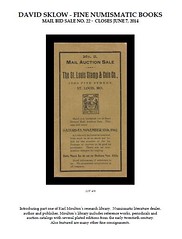 Just one week left to enter your bids in Numismatic Literature Sale # 22 closing Saturday June 7, 2014. The sale features Part One of the Karl Moulton Library, rich in auction sales and much more. Several other consigners present items from every corner of the hobby.
Just one week left to enter your bids in Numismatic Literature Sale # 22 closing Saturday June 7, 2014. The sale features Part One of the Karl Moulton Library, rich in auction sales and much more. Several other consigners present items from every corner of the hobby.
Rare items include, examples of the only deluxe sale catalogs B. Max Mehl issued; a nice run of early sale catalogs from the ANA Conventions of 1907 - 1952, including the extremely rare 1917; a complete set of the Numismatic Scrapbook, in original covers; several of Q. David Bowers' works inscribed by him to John J. Ford, Jr; long run of Thomas L. Elder sales, including plated Mougey and Lawrence examples; run of Kosoff sales, many deluxe examples; long run of B. Max Mehl sales; run of the Colonial Newsletter; runs of Jess Peters, Norman Shultz and a fabulous run of from the St. Louis Stamp & Co.; run of The Numismatist in original covers; run of nineteenth century sales; some nice hard bound Bowers & Merena sales; a 1798 annotated James Conder on Provincial coins, tokens and medalets; Two volume set -American Autographs by Charles Hamilton; deluxe interleaved Wayte Raymond, Coins of the World, 1938; rare Society of Bearded Numismatists Journal issue number one; short run of the Sylloge Nummorum Graecorum; Super Deluxe Full Leather A California Gold Rush History, Q. David Bowers; Rare ANA 50 year Gold Membership Longevity medal first year of issue;
Sale closes Saturday, June 7th at 8 PM Mountain time. Bids may be placed via mail, email, telephone and fax, bids left on our answering service, faxed or emailed will be accepted until midnight closing day, the phones will not be answered after 8 PM; be sure to check your bid sheets for errors, and remember, Bid early and often!
Thank you,
David
David Sklow-Fine Numismatic Books
P.O. Box 6321
Colorado Springs, CO 80934
PH: 719-302-5686
FAX: 719-302-4933
Email: numismaticbooks@aol.com
Web Site: FineNumismaticBooks.com
NEW BOOK: 100 GREATEST U.S. MODERN COINS, 3RD EDITION
Whitman Publishing announces the release of the third edition of 100 Greatest U.S. Modern Coins, by Scott Schechter and Jeff Garrett. In this beautifully illustrated book, two award-winning numismatists take the reader on a guided tour of the post-1963 circulating, bullion, and commemorative issues so avidly sought by collectors today. The 128-page coffee-table book will be available on the 4th of July, 2014, online (including at WhitmanBooks.com) and from booksellers and hobby shops nationwide.
100 Greatest U.S. Modern Coins is the eighth entry in Whitman Publishing’s 100 Greatest™ library. Preceding books showcase American and ancient coins; paper money; medals and tokens; comic books; and stamps.
The 100 Greatest were selected and ranked by the authors with input from leading coin dealers, researchers, and collectors, and a survey of current hobby journals and periodicals.
The ranking includes prized and seldom-seen rarities—the scarce and high-valued pieces that collectors dream about. Some are errors, like the famous 2000 Sacagawea dollar / Washington quarter mule. Some are die varieties, like the 1972 doubled-die obverse Lincoln cent and various “No S” Proof coins. A few are coins that shouldn’t exist, like the mysterious 1964 Special Mint Set coinage and the Wisconsin “Extra Leaf” quarters. And many are coins with small mintages or poor distribution, or that collectors weren’t interested in when they were first released—factors that make them scarce (and therefore eagerly sought) today.
“We decided that all the coins on the list should be collectable,” says author Scott Schechter. “Potentially illegal coins are not. This explains why the 1974 aluminum cent was dropped from the first edition, and why several other coins are absent: the fabled 1964-D Peace dollar and the 2000-W Sacagawea dollar struck in gold, for example.”
Author Jeff Garrett points out that American Eagle and American Buffalo gold bullion coins remain popular among the 100 Greatest moderns. New rankings in the third edition include the 2013-W Enhanced Uncirculated American Silver Eagle and the 2013-W Reverse Proof American Buffalo gold piece.
The book also explores more readily available coins: pieces so beautiful or with such important and fascinating stories that everybody wants one. The 1999-S silver Proof Delaware quarter, the 1996-W Roosevelt dime, the 1983-P Washington quarter, the 1982 Washington commemorative half dollar, and dozens more are pictured in bold full color, with their stories told in engaging detail.
The book includes forewords by numismatic legends Kenneth Bressett and Q. David Bowers. An illustrated introduction answers the question, “What are modern coins?” (As a starting point, Schechter and Garrett discuss 1964 as a pivotal year for modern coinage.) The introduction also covers methods of modern coin manufacture and packaging; the differences between varieties and errors; types and surface finishes of modern U.S. coins; varieties and errors; and how the 100 Greatest were chosen and ranked.
A new section on “Modern-Coin Grading Essentials,” by NGC chairman Mark Salzberg, rounds out the third edition’s front matter.
Throughout the book, Schechter and Garrett describe how to collect and enjoy U.S. modern coins, aspects of the marketplace, and smart buying.
Ken Bressett, senior editor of the best-selling Guide Book of United States Coins, calls 100 Greatest U.S. Modern Coins “compelling.” In his foreword he writes, “You will be not only fascinated by the coins, but also thrilled to know that some can actually be found in your pocket change. They disprove the axiom that all the good coins are gone from circulation.”
Q. David Bowers, the “Dean of American Numismatics,” in his foreword writes about the hobby’s growing passion for die varieties, the rebirth of the U.S. commemorative coin program, and other aspects of modern collecting. “I enjoyed reading about my own favorite coins,” he said, “but also came to appreciate many I had overlooked.”
Various Reverse Proof bullion pieces, the “Cheerios” Sacagawea dollar, the 2009 Ultra High Relief double eagle, “Godless” Presidential dollars, Speared Bisons, and more await the reader of 100 Greatest U.S. Modern Coins, third edition.
The book is coffee-table-size, 128 pages, in full color, with photographs and stories for every coin. It also includes market values, field populations, certified-coin census reports, quantities minted, specifications, and design notes.
100 Greatest U.S. Modern Coins will be available July 4, 2014, online and from hobby shops and bookstores nationwide.
100 Greatest U.S. Modern Coins
Authors: Scott Schechter and Jeff Garrett
Forewords by Kenneth Bressett and Q. David Bowers
ISBN 0794842356
Full color, illustrated, 128 pages.
10 x 12 inches.
Hardcover.
Retail $29.95
URL:
https://www.whitman.com/store/Inventory/Detail/100-Greatest-U-S--Modern-Coins-3rd-Edition+0794842356

NEW BOOK: COMMERCIAL COINAGE OF KOCH KINGDOM
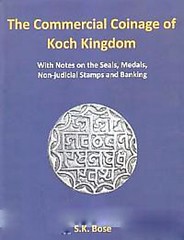 The Commercial Coinage of Koch Kingdom: With Notes on the Seals, Medals, Non-Judicial Stamps and Banking
The Commercial Coinage of Koch Kingdom: With Notes on the Seals, Medals, Non-Judicial Stamps and Banking
Authors (s): S.K. Bose (Author)
Format: Hardcover
ISBN-13: 9789351265474
Pages: 152p., Illustrations; Some Colour; Maps; Some Colour; 25cm.
Pub. date: 31.12.2013, 1st. ed.
Publisher: Mira Bose
Language (s): English
Bagchee ID: BB85383
List price: US $ 76,00
Bagchee price: US $ 68,40
This book attempts to examine the unexplored aspects of the commercial coins of Koch Kingdom, now known as Cooch Behar, in Northeast India. Presenting a comprehensive elucidation of numismatic details of the commercial coins, it enriches its great worth by adding the notes on seals, medals, non-judicial stamps and banking.
Based on unexplored and unexposed materials, including archival records, it also studies the coins of Islam Shah and the rare coins of Lakshminarayana of Cooch Behar. It provides a window to regional economic history as well. The photographs of legends on the coins make part of the book.
For more information, or to order, see: The Commercial Coinage of Koch Kingdom: With Notes on the Seals, Medals, Non-Judicial Stamps and Banking (www.bagchee.com/books/BB85383/the-commercial-coinage-of-koch-kingdom-with-notes-on-the-seals-medals-non-judicial-stamps-and-banking)
NEW BOOK: PUNCHMARKED COINAGE OF THE INDIAN SUBCONTINENT
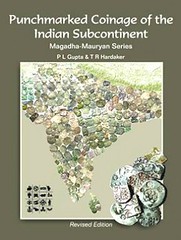 Punchmarked Coinage of the Indian Subcontinent: Magadha-Mauryan Series
Punchmarked Coinage of the Indian Subcontinent: Magadha-Mauryan Series
Authors (s): P. L. Gupta (Author) , T. R. Hardaker (Author)
Format: Hardcover
ISBN-13: 9788186786352
Pages: 296p., Bibliography; 1000 Illustrations; 6 Maps; 26 Tables;
Index; 280 x 215mm.
Pub. date: 14.02.2014, Revised/Edition
Publisher: Indian Institute of Research in Numismatic Studies
Language (s): English
Bagchee ID: BB84387
List price: US $ 133,00
Bagchee price: US $ 119,70
The long-awaited second edition of this Catalogue of Indian punchmarked coins – ‘GH’ as it has become known - is at last available, twenty-nine years after its first publication. It introduces the new data and types accumulated over this period.
Nearly three times the length of the first edition, the book has been extensively rewritten by the surviving author (Hardaker) and is superbly printed with clear photographs including three colour maps. Whereas the original volume catalogued 613 types, this edition includes 1043 and expands the original seven Series to nine. These now include the pre-karshapana coinages of the early Magadhan state as ‘Series 0’, and the post-Mauryan karshapana-like coinages as ‘Series VIII’.
Many improvements have been made. The Catalogue section (132pp) includes photos next to the symbol drawings. The task of identification is made easier with extensive symbol lists, guidance on rarity, and a ‘critical path’ chart, as well as a 35-page section of enlarged photos. Users of the first edition will be glad to see that the old type numbers are retained, new types being added by way of ‘a’, ‘b’, etc.
The first two Introductory sections (57pp) provide some exciting insights into Magadha-Mauryan coinage resulting from ongoing study since the 1980s. The narrative is set into the wider context of late Iron Age society. The bankers and other additional marks seen on these coins are for the first time classified into chronological phases, and the way these marks can be used to reconstruct the economic and social history of the period is described. Recent research, including much fresh hoard evidence, is evaluated in the discussions on chronology and date, and the most likely options are laid out. Especially interesting is the progress that has been made in the chronology of the Series I coins which now total 505 types.
The text demonstrates how close-focus study of coinage can expose specific moments in time, such as a mint workman’s catastrophic error (pictured above), while also illuminating the broader thinking underlying society in an age on the cusp of historic time. The coins show financial dealers battling with iron-fisted state control, engravers improving their skills in fulfilling complex design directives, and finally the collapse of society at the end of the Mauryan period.
This will remain the standard reference work on the karshapana series for many years to come.
For more information, or to order, see: Punchmarked Coinage of the Indian Subcontinent: Magadha-Mauryan Series (www.bagchee.com/books/BB84387/punchmarked-coinage-of-the-indian-subcontinent-magadha-mauryan-series)
NEW BOOK: AMERICAN RED CROSS WWII COLLECTOR'S GUIDE
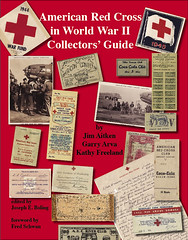 According to the introduction, the authors "have included every numismatic item we could find and some of the window dressing as well. To at least a small degree we have touched on the Red Cross in nine established fields of collecting: numismatics, deltiology, philately, autograph collecting, map collecting, ephemera, sports memorabilia and militaria."
According to the introduction, the authors "have included every numismatic item we could find and some of the window dressing as well. To at least a small degree we have touched on the Red Cross in nine established fields of collecting: numismatics, deltiology, philately, autograph collecting, map collecting, ephemera, sports memorabilia and militaria."
Of course numismatics proper is covered with the inclusion of chits, short snorters, checks, trench art and war funds. The book is in color with a lot of great pictures and images many of which were from the collections of Festers and Gramsters. The meat of that is a listing of ARC chits from around the world. This listing is based on the Garry Arva collection.
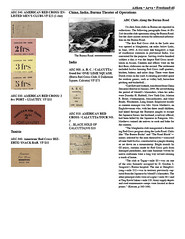
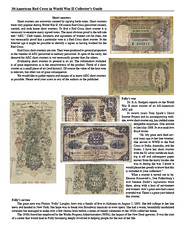
The book is available at the introductory price of $22 postpaid by writing me at fredschwan@yahoo.com. The same email may be used for PayPal if desired.
NEW BOOK: FORBES LITHOGRAPH CO. IN WWII
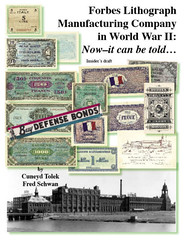 Forbes Lithograph Manufacturing Company in World War II: Now I it can be told ... Insider's draft
Forbes Lithograph Manufacturing Company in World War II: Now I it can be told ... Insider's draft
by Cuneyd Tolck and Fred Schwan
This is a very interesting brand new book. It was released on May 3, 2014 at MPCFest in Port Clinton, Ohio. It was years in the making by the authors and other well-known collectors. Forbes Lithograph Manufacturing Company printed over 4 billion Allied notes during World War II. At the end of the war, the company produced its own history of its work during the war. The book is huge with many actual products attached to the pages (including the some of the notes).
This new book by collectors Cuneyd Tolek and Fred Schwan is the story of Forbes during the war AND of that remarkable book produced by the company.
The original Forbes book includes great and detailed photography of the Allied military currency in production and details that were not known to the collecting public until now. The new book reproduces every page of the original in full color with additional information and commentary as appropriate.
The authors believe that fewer than 10 of the original Forbes books were produced. Only 50 numbered copies of the new book have been produced. Only four remain, so if you want one of these interesting new books, you should jump on it right away.
To read the complete eBay listing, see: Allied military currency and more: the story of Forbes Litho in World War II (www.ebay.com/itm/Allied-military-currency-and-more-the-story-of-Forbes-Litho-in-World-War-II-/331215598720)
TOKEN, MEDAL AND POLITICAL AUCTION
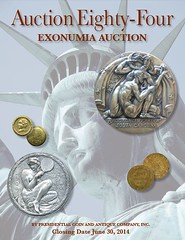
Presidential Coin & Antique Co., Inc.'s Auction Eighty-Four of Tokens, Medals and Political items closes June 30, 2014. Hardcopies $6 - contact Joe Levine at Jlevine968@aol.com or view the catalog online here .
Hard Times Tokens, 19th Century Storecard Tokens, Civil War Tokens, Military & Related, So-Called Dollars, Presidential & Political, World's Fairs & Expositions, U.S. Mint Medals, ANS Medals, Foreign Tokens and Medals, and MORE!
BOOK REVIEW: BY ITS COVER
 By its Cover by Donna Leon (Atlantic Monthly Press, $26)
By its Cover by Donna Leon (Atlantic Monthly Press, $26)
The 23rd Commissario Guido Brunetti mystery is a must for bibliophiles. Brunetti practices his craft in Venice, Italy where he is hugely outraged by the human depravity and conspicuous corruption he constantly confronts in his beautiful city.
Here he is called in to investigate the theft and depredations committed on rare books at a small but prestigious Venetian library. There are many echoes of the 2012 theft and vandalism that occurred at the Girolamini Library in Naples where its director systematically stole thousands of rare books.
Brunetti finds rare books missing and others where single pages of maps and illustrations have been sliced out. As one of Brunetti's colleagues puts it. "It would make a stone weep." Brunetti has trouble understanding the loss of value caused by an excised page. He learns that a rare book with one illustration gone loses half its value. He is bemused that if the text is intact, that there is little loss of the knowledge itself, why then is the book so greatly devalued. Brunetti is not a collector, and has little or no understanding of the forces that drive the urge to collect. He spends the entire investigation, like the proverbial Diogenes, looking with his lamp for the true book collector and what moves him.
This is a fine puzzle but the real joy is watching a man for whom knowledge is important but not the covers within which it is housed work out the various motives that drive the librarians, patrons, donors, collectors, readers, buyers, sellers and thieves to that most precious artifact - the rare book.
The cherry on top is a wonderful recipe for an artichoke appetizer that this reviewer salivated over at first reading.
To visit the author's web site, see: www.donnaleon.net
AUREO & CALICÓ NUMISMATIC LIBRARY IN PROMOTIONAL VIDEO
E-Sylum readers might salivate when viewing just a snippet of this library and facility at a Spanish coin dealer- Aureo & Calicó. Nicely produced video to celebrate the firm's 25th anniversary.

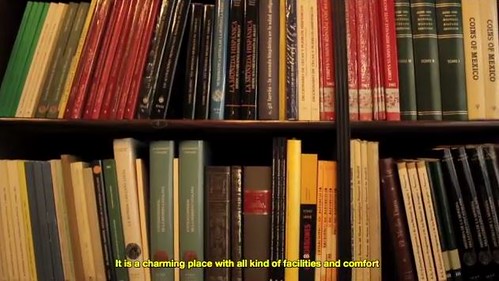
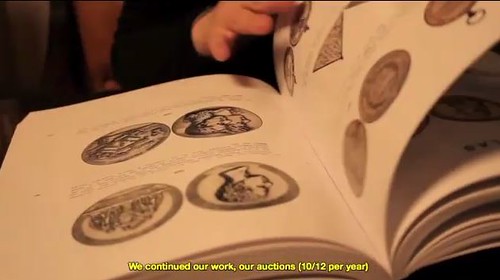
To view the complete video, see: VER VIDEO PRESENTACIÓN DE AUREO & CALICÓ (/www.aureo.com/presentacion.php?iframe=true&width=700&height=475)
MORE ON ERIC P. NEWMAN
This one is from Colonial Coin Collectors Club officer Ray Williams, who writes:
Here's a picture of Eric as our featured speaker during our C4 Educational Forum in 2001, when he was a spry 90 years old! Looking at that tie, I think someone at the Newman Sale was wearing that exact tie!!!
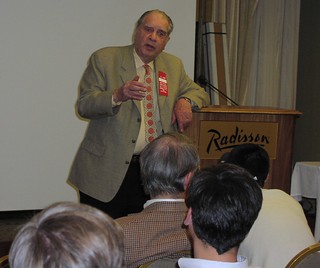
Photo by Craig McDonald
Beth Deisher writes:
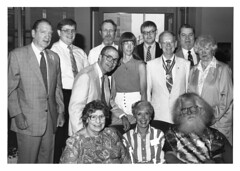 The black and white image supplied by Ken Bressett was taken by me and it is from Coin World's archives. I provided it to him a couple of years ago when we were trying to confirm the date.
The black and white image supplied by Ken Bressett was taken by me and it is from Coin World's archives. I provided it to him a couple of years ago when we were trying to confirm the date.
I'm pretty sure it was taken after the Rittenhouse Society's meeting during the 1984 ANA Convention in Detroit. Bill Fivaz and his wife Marilyn attended the Rittenhouse Society breakfast meeting. However, Bill had to leave early to attend another meeting; thus he is not in the picture. I was on my way to cover another meeting when Margo saw me in the hallway and asked me to take a photo of the Rittenhouse group.
To read the earlier E-Sylum article, see: HAPPY BIRTHDAY, ERIC NEWMAN! (www.coinbooks.org/esylum_v17n22a02.html)
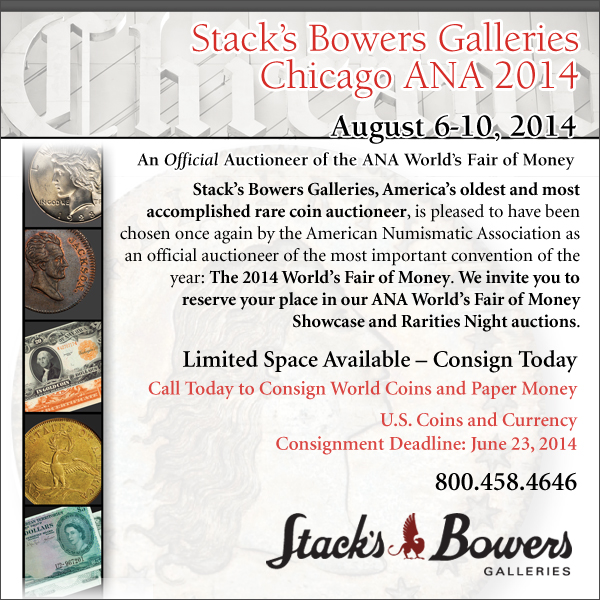
ON THE TRAIL OF THE NEW ENGLAND STIVER
Alan V. Weinberg writes:
I remember New Jersey collector/vest pocket dealer David L. Dokus well (having been a reasonably close friend and having visited his home often) Dave was a frequent owner of superb early American coins back in the early 1960's. Perhaps his closest friend was collector Ken Morrison of New Jersey colonial copper fame.
At one particular time Dave had a nice Higley, a choice red & brown Unc Vermont cent, the New England stiver and an Immune Columbia / eagle New York colonial pattern (now 2 known), all acquired out of a famous New Jersey colonial collection. Both the stiver and the NY pattern were said at the time to be fantasies and Dave was devastated by this singular condemnation.
I was by then (early to mid 1960's) a serious colonial coin collector and expressed my view that both coins were in fact legitimate. But they had been "poisoned" in the marketplace by their fantasy condemnation.
Dave has long since passed on but my best guess is that these coins may have ended up in Bill Anton's collection as Bill knew Dave well and lived relatively close by. And no, Bill was not the person who condemned the two coins.
To read the earlier E-Sylum article, see: QUERY: WHERE IS THE NEW ENGLAND STIVER? (www.coinbooks.org/esylum_v17n22a14.html)
NOTES FROM E-SYLUM READERS: JUNE 1, 2014
Redeeming the Kolbe Bookseller Token George Kolbe writes:
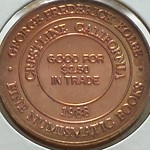 Last week Linda and I were at the Grand Canyon with our 8 and 10 year old grandkids and I did not get around to responding to the query about the GFK tokens. Over the years, I have commissioned two. An earlier one, the size of a small cent, was produced by Jesse Patrick at the Patrick Mint. Pete Smith summarizes the details surrounding the large cent-sized one well.
Last week Linda and I were at the Grand Canyon with our 8 and 10 year old grandkids and I did not get around to responding to the query about the GFK tokens. Over the years, I have commissioned two. An earlier one, the size of a small cent, was produced by Jesse Patrick at the Patrick Mint. Pete Smith summarizes the details surrounding the large cent-sized one well.
A number of years after its issue, I received an order for a book from one of my “Numismatic Bookseller" fixed price lists, accompanied by a check. The written amount, however, was $5.00 less than the price quoted. You guessed it! The order was accompanied by TWO Kolbe tokens. It amused me for days thereafter and still does. Those two were the only ones ever redeemed.
To read the earlier E-Sylum article, see: THE GEORGE KOLBE BOOKSELLER TOKEN (www.coinbooks.org/esylum_v17n22a13.html)
Industrial Revolution Hobo Nickel
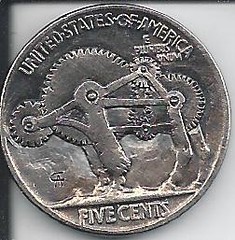 Fred Michaelson writes:
Fred Michaelson writes:
The May 18th E-Sylum had a great hobo nickel by Alan Chernomashentsev. I have another one that he did, attached, titled "Industrial Revolution." It's one of the top nickels in my collection.
To read the earlier E-Sylum article, see: GENE & TOM'S NUMISMATIC DIARY: MAY 18, 2014 (www.coinbooks.org/esylum_v17n21a19.html)
More on the Roman Coin Mould Regarding the mould for minting Roman coins discussed late week, Bob Leonard writes:
I would point out that if this object is indeed terracotta it must be a mould and not a die. Also, Livia is not a "Greek goddess" but the mother of the Roman emperor Tiberius. This mould would be for a denarius or aureus of Tiberius and probably reads PONTIF MAXIM. (The denarius of this type is usually considered to be the "Tribute Penny" of the Bible.)
To read the earlier E-Sylum article, see: MOULD FOR COUNTERFEIT ROMAN COINS EXHIBITED (www.coinbooks.org/esylum_v17n22a25.html)
Brilliant Uncirculated To Fine Condition Steve Bishop writes:
While reading the last E-Sylum, an ad came on the TV for some company selling Morgan silver dollars. They were guaranteed to be in "brilliant uncirculated to fine condition." What do you bet that if you ordered one you would get a well-worn coin?
FINAL ARRANGEMENTS FOR JOHN H. BURNS

I have made arrangements for the burial of John Burns. Please forward to anyone you know that also may be interested.
Raymond Henry Burns (father)
Vivian Scott Burns (mother)
John H. Burns (son)
Greensburg Union Cemetery
Greensburg, PA
Arrangements by:
Barnhart Funeral Home, Inc.
505 E. Pittsburgh St.
Greenburg, PA 15601
Friends and family members of the Burns family are welcome to attend.
The cremated remains of Henry, Vivian, and John Burns will be laid to rest with a service on Saturday June 7, 2014. We will meet at the Barnhart Funeral Home at 9:30am and will proceed to the Greensburg Union Cemetery for a graveside service.
For any questions or details contact:
Patrick McBride
John Burns’ Administrator
412-973-3525
THE BOOK BAZARRE
HOBO NICKELS AND ETHNIC SLURS
Regarding the Hobo Nickel "I VILL" forwarded by Larry Dziubek a few weeks ago, Bob Leonard writes:
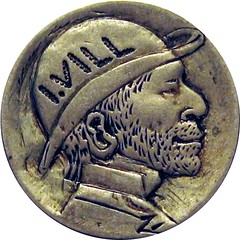 I.VILL has nothing to do with a marriage proposal: it pokes fun at Jewish immigrants from Eastern Europe who pronounced "W" as "V." The figure represents a "sheeny," a Jewish man with a hook nose wearing a derby hat; he is no "hobo."
I.VILL has nothing to do with a marriage proposal: it pokes fun at Jewish immigrants from Eastern Europe who pronounced "W" as "V." The figure represents a "sheeny," a Jewish man with a hook nose wearing a derby hat; he is no "hobo."
The ethnic slur nature of the original "hobo nickels" has been swept under the rug by modern collectors, but it is established by the existence of pot metal tokens imitating this design on the obverse, with the pawnbroker's three balls on the reverse.
Several of us involved with OHNS have privately discussed the history of some hobo nickels that were clearly created with an ethic slur as part of the design or legend. We really haven't discussed this in print. In authenticating or grading old hobo nickels, we often refer to an exaggerated nose as an "ethnic nose."
I have attached two articles printed in BoTales, the quarterly publication of OHNS. The first entitled "Kosher Carvings" was written by our OHNS late webmaster and secretary Verne Walrafen. It appeared in the summer 2010 issue of BoTales.
In the spring of 2012 Verne unexpectedly passed away or as we refer to it, he caught the westbound. Then later in 2012 I received a letter from OHNS member Ira Rezak which I published in the fall 2012 issue of BoTales.

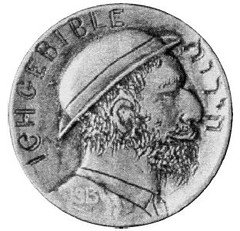
The Hebrew seems to me to be a slight misspelling (חירות instead of the proper חרות) of the word for “liberty”, which of course is merely a translation of the very word that had originally occupied this area, albeit in English.
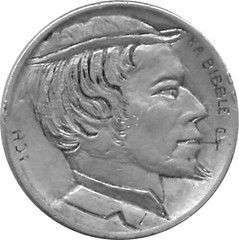 The meaning
of “Ich Gebible” is much discussed in dictionaries of regional English but is actually not to be found as such in Yiddish dictionaries. The internet is rich in discussions of what this expression might mean, but two things are very clear: its usage dates back to about 1913 (the preserved underdate on this nickel), and it was the stage name of Merwyn Bogue, a non-Jewish comedian, popular on radio in the 1930s and 1940’s who used the expression in a nonsensical kind of way as part of his routine. Both of these facts are well attested.
The meaning
of “Ich Gebible” is much discussed in dictionaries of regional English but is actually not to be found as such in Yiddish dictionaries. The internet is rich in discussions of what this expression might mean, but two things are very clear: its usage dates back to about 1913 (the preserved underdate on this nickel), and it was the stage name of Merwyn Bogue, a non-Jewish comedian, popular on radio in the 1930s and 1940’s who used the expression in a nonsensical kind of way as part of his routine. Both of these facts are well attested.
While there is much speculation on-line about what Yiddish expression might have led to the invention and wide use of this obviously humorous expression (one such idea is that it might have derived from the Yiddish for “what me worry”), the more probable explanation is that it was simply a silly sounding phrase use in many contexts when mockery of foreign accents in public comedy was widely accepted ( eg. Amos n’ Andy, Sid Caesar) and was not yet considered politically incorrect.
Finally, I attach separately a picture of a Hobo nickel featuring the name ”ICH KA BIBBLE” in my own collection that was purchased from Richard Rossa in 1975. I don’t know very much about Hobo Nickel portraiture but, as a member of the OHNS for the past few years, it seems safe for me to say that the sharp nose and piercing eye, the pointed beard, the tooth-bearing open mouth, and the lack of any ear definition at all, if also the presence of a pipe, make this specimen atypical of the more usual forms of carving.
To read the earlier E-Sylum article, see: HOBO NICKELS: I VILL AND JASON'S UNCLE (www.coinbooks.org/esylum_v17n19a28.html)
READER COMMENTS ON NUMISMATIC POSTCARDS

With a lot of interest I have read The E-Sylum about numismatic postcards, Volume 17, Number 3, January 19, 2014.
I myself am a collector of these cards and come over to this cards by collecting Danish coins. Have seen this cards many years ago at a coin fair and wanted to have one card in addition to my collection. In meantime I have 30 different Danish cards of HSM, MH and Walter Erhard and know of two more.
Walter Erhard was the last publisher of coincards and his cards are without a flag. One of my cards of MH is also without a flag. All cards of HSM and MH are in German, French or English, the cards of Walter Erhard always in more languages. During the time of MH and Walter Erhard there were also printed many countries special for the Czech Republic.
Two of my cards have different prints from “PAPETERIE FORTUNA” in Vienna with information that they are the distributer of the cards – All over the world without Germany.
The cards are used for money exchange. I have a card where an English banker has made notes for exchange. The latest cards of Walter Erhard are sure not useable, because the first World War and inflation let go cash value down. But there are also other reasons. The Nordic and Latin coin unions had been ended.
I have opened my collection for countries all over the world. First I wanted to know how many countries are issued and I found out in meantime 61 different countries.
The time of issue must be before 1914. I have a Danish card, English printed, that is written at 7.2.1904 in Argentina. It could not be that these cards were in Argentina in 1904 in such a short time. The problem is that that fewer cards are used for posting and often you cannot see the print exactly.
I am always interested in information about coin cards. Please forgive my bad English, but I must use it very seldom.
With best regards
Hans-Joachim Bergmann
Elchweg 9
89542 Herbrechtingen
Germany
To read the earlier E-Sylum article, see: MORE ON NUMISMATIC POSTCARDS AND ALBUMS (www.coinbooks.org/esylum_v17n03a12.html)
FOURTH NATIONAL BANK OF THE CITY OF NEW YORK $1000 PROOF

What one expert calls a "flawless and complete" piece of numismatic history is up for auction Thursday, and aficionados of paper currency are registering to bid -- in person, by phone or by web.
To be auctioned is a proof of an original series $1,000 national bank note issued on March 1, 1864, by the since defunct Fourth National Bank of the City of New York.
"I flipped over it," said Philip Weiss, who is handling the auction at his Lynbrook location, Philip Weiss Auctions. "I thought it was fantastic."
Only one other such proof, in less desirable condition, had been known to exist, he said. It was photographed for a book about U.S. paper money published in 1955, with the piece's whereabouts now unknown.
The survival story of the soon-to-be-auctioned proof is likewise unknown, Weiss said. That's up to the point a few months ago when the piece surfaced at an estate sale in Manhattan where it was bought and resold to the dealer who brought it to Weiss.
The proof would have been lifted from the plate used to print genuine notes and sent to the U.S. Treasury for design approval, wrote U.S. currency expert Peter Huntoon in a recent issue of the Bank Note Reporter.
As for finding the real McCoy -- one of those original $1,000 notes issued by various banks around the same time -- chances may be slim, but "I wouldn't say impossible," Weiss said. As of 1938, there were 21 such $1,000 notes from that era that the Treasury Department considered outstanding, according to Huntoon.
Indeed, with "the purchasing power of well in excess of $100,000 in today's dollars," the $1,000 notes weren't in general circulation at all, Huntoon wrote, with most sitting "unused in the banks of issue." Still, fellow bankers would know colleagues had the "raw power" of those high-denomination notes, making them "just like trophy wives today."
According to the Bureau of Engraving and Printing, U.S. currency notes of $1,000 were issued until 1969, when the Treasury Department and the Federal Reserve announced they were discontinued "due to lack of use."
To read the complete articles, see:
Historic $1,000 bank note proof up for bid at Lynbrook auction
(www.newsday.com/long-island/nassau/historic-1-000-bank-note-proof-up-for-bid-at-lynbrook-auction-1.8234772)
Proof of rare bank note sells for nearly $100,000 at Lynbrook auction
(www.newsday.com/long-island/nassau/proof-of-rare-bank-note-sells-for-nearly-100-000-at-lynbrook-auction-1.8265559)
THE BOOK BAZARRE
INTELLIGENT COLLECTOR INTERVIEWS GENE GARDNER
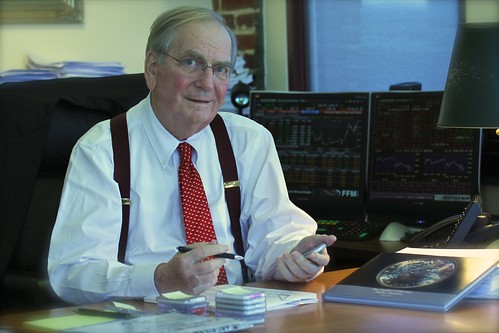
When did you make the jump from kid collector to spending serious money as a serious collector?
It started in 1955. Coin prices were not that high. If you spent $10 or $15 on a coin, that was something. I collected a whole set of Indian proof pennies that were part of the estate of [noted numismatist] Wayte Raymond [1886–1956], and those were gorgeous. They would be [grade level] 67s, at least, today, perhaps 68s. They were truly gorgeous, but they cost 10 bucks. I sold those in 1965, 10 years later, for about $60 or $70. The coins were special. They brought a high price. Today, they would be hundreds or thousands of dollars. So when you ask when I first spent real money on coins, I don’t remember. But it was not significant. It was a little bit here and there.
You purchased coins from the Jordan Marsh department store in Boston back then?
They had a coin department in the basement. They didn’t have super coins, but they had interesting coins, and I bought several. I got to know the dealers in the Boston area. Malcolm Chell-Frost was a person I was close to. I didn’t realize it at the time, but he was really nationally known. He was a contributor to the Red Book guide, a significant numismatist, and a terrific person. The first real coins I bought were from him. I would go down there two or three times a week and he would ration them out to me. I knew he had more, but he would only sell you a couple at a time.
After your 1965 auction, what brought you back to collecting?
It was just a random chance. I was in New York one day, walking along 57th Street, and I walked past Stack’s and something was going on. They were having an auction that night, so I stayed around. It was sticker shock. It was unbelievable. Coins I thought were worth $10, $15 or $20 were suddenly worth $1,000, $1,500, $2,000. But I couldn’t sit still for the whole thing so I bought a 1909-S VDB Lincoln cent. Not a particularly distinguished coin. I paid $935 for it in 1995. It was OK, but it wasn’t the quality I actually would go after. I was very uncertain. I sort of spent the rest of 1995 being about that serious … nosing around but not doing much about it. And then in 1996 was the Eliasberg auction, and that was my first real jump back in.
The second time around, you were more focused?
Well, I had some knowledge, but not enough to really be successful. For instance, when the Eliasberg coins went up for sale, I bought an 1876-CC Liberty Seated 20-cent piece. I knew it was a rare coin and it was the fifth auction lot, so I just bought it. I had no idea if I’d paid too much or too little. I paid $148,500 for it, which at the time everybody seemed to think was a remarkable price. The good news is it’s worth more today. The coins in Eliasberg were all raw. They were not graded. So it was dependent on your ability to grade, and frankly my ability to grade was zero – certainly compared to the people I was competing with, who were some of the real experts in the field. But I was familiar with rarities.

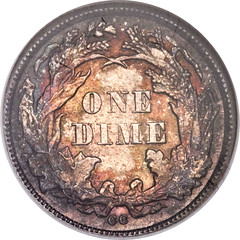
Why have you focused on Seated Liberty coins?
That’s just the way the collection developed. I’ve wound up with an unbelievable collection of Liberty Seated coins. I’ve collected all series. The dollars, half dollars, quarters, dimes, half dimes. They are all complete, in high-grade mint state, probably averaging [a grade of] close to 65 and 66. And I’ve also collected them complete in proof, from 1837 to 1891 – in all series, missing only one coin, the 1853 half dime. That’s the way the collection developed. I always had an affinity for the quarters. People kept saying “You’ll never complete the quarters. You just can’t do it. They are the toughest series to complete in highest quality.” That just spurred me on.
To read the complete issue online, see: www.intelligentcollector.com/mag/2014-5/
1864 MASONIC ENGRAVED HALF DOLLAR
Coins are boring. I mean the coins you’ve seen a million times that aren’t interesting anymore. Turn them all into eBay junk lots, because this month we have something much more interesting to consider. I’m sure quite a few of us are constantly surfing the Internet checking out the latest dealer listings, and once in a great awhile you find something which grabs the attention - like this offering from John Kraljevich Americana:

What we have here is an 1864 half dollar. It is nicely toned, and the surfaces appear to be relatively mark free – aside from the engraving, which has quite a tale to tell. The story starts with the reverse, which is inscribed “Taken from the ruins of Masonic Temple / April 6th 1864.” This refers to the fire which destroyed the Boston Masonic Temple in 1864. Masonry was quite the thing in the early days of our country, more popular than now, and these cathedral-like buildings popped up in the large cities. If you’ve walked around downtown Philadelphia, you’ll get an idea – that Masonic temple, at Penn Square, remains in its original glory.
In Boston, there was nothing left to do but rebuild, and a new temple was raised several years later. But relics were taken from the charred remains in 1864, including ceremonial silver implements which were delivered to the Mint in Philadelphia to be coined into half dollars. (An intrepid researcher is currently searching for the deposit record in the Mint Archives, and we eagerly await his results.)
This coin thus falls into the category of relic coin, a situation where the source of the bullion for a particular coin is well-known. There are other examples in the American series, such as the 1848 CAL. GOLD quarter eagles (coined from the first gold shipment from California to the US Mint), or the 1794 silver dollars, for which the bullion was deposited by the Mint Director David Rittenhouse.
Then there is the mythology of George Washington supplying the bullion for the 1792 half dismes, for which some, but not definitive, evidence exists. Do you sense a theme – all these coins are really expensive! The current coin is somewhat less pricey, but not cheap. Mr. Kraljevich always does his best to separate me from my money, and I am trying to hold out, but this coin is making it very hard. Relic coins represent something more than just a coin – what we have here is a high degree of historicity, and if the dealer happens to have academic training as a historian, the asking price will be set accordingly.
Gregory Brunk, in his reference on counterstamped coins, argued that this coin is correctly called a commemorative coin. After thinking about this, it occurred to me that the coin collector’s lexicon is not always so precise. What exactly is a proof coin? Some of the Liberty Seated issues are deceptive – proof dies were used for circulation strikes. If the coiner ran off a few hundred coins and set them aside as proofs, how are those coins any different from the very next coin that came off the die?
This extends to other situations – few of us considered the precise definition of a “vote” until the 2000 Presidential election. We now even wonder about death – if a person has no brain activity, are they dead? Now that I’ve introduced religion and politics into the equation, let’s get back to coins. What makes a commemorative coin? They are “one-off” issues typically tied to a specific historical event – clearly we have that here. Of course, we don’t have the legislation that accompanies commemorative issues , which is the strongest argument against commemorative status in this case.
There are about dozen known examples of these “Masonic” half dollars, one of which is in the Massachusetts Historical Society and was exhibited during the 2010 Boston ANA. That piece is similarly engraved on the reverse, and the obverse is engraved “Wm. Hurd Boston Encampment.” Hurd was a member of the Boston Masons, and the present piece in the Kraljevich inventory is similarly engraved to a member of the Boston group: "Presented to Sir KT R H Carleton / by / Sir KT D.W.W. / Boston." Kraljevich notes that “KT is an abbreviation for Knights Templar. RH Carleton appears to be Robert H. Carlton, who marched in the 1868 procession to mark the opening of the new Masonic Temple in Boston….” The identity of D.W.W. is unclear, but it seems quite likely he was a lodge brother of Carleton.
Among Liberty Seated coinage, this one is unique – in no other case can we tie specific bullion to specific coins. Combined with the rarity of the emission (the exact mintage may eventually be discovered in the Mint records – perhaps 30 pieces?), and the overall choice condition of this particular specimen, there is a lot to like here.
For more information on the Liberty Seated Collectors Club, see: www.lsccweb.org
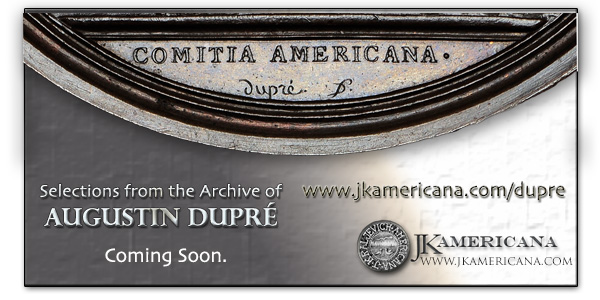
HOW TO COEXIST PEACEFULLY WITH YOUR BOOKS
I love books. Not just reading them, but how they smell, the weight of them in my hands, the feel of the pages when I turn them. So naturally, I have a lot, culled from all stages of my life.
At some point, though, I realized that the way my books were crammed into every available space didn't accurately reflect their importance to me. They also looked like an afterthought, when really, they're anything but. I was in desperate need of an intervention.
I sent photos of my "bad bookcase" to several designers and organizers to get their suggestions of how best to display my book collection.
No one suggested getting rid of books — good, because that's not an option for me. This wasn't an exercise in de-cluttering; it was an attempt to find a way to cohabitate with my books and let them shine.
That's a sentiment Tracy Morris, a book lover herself and principal designer at Tracy Morris Design in Washington, often hears.
"As long as you do it tastefully, so it's beautiful and clean, you can put them anywhere your heart desires," she said. "Books are an enormous part of creating texture and warmth in a house."
And displaying books in combination with other meaningful treasures can turn them from clutter into a conversation piece, said Andreas Charalambous, principal architect at Forma Design in Washington.
"If you provide someone with the infrastructure or backdrop to place things in an orderly manner, it ends up being pleasing to look at," Charalambous said. "You don't want to just hide these things behind a closet door, because then they lose the importance that they have."
So how can bibliophiles hang onto their treasures while keeping their house from being featured on "Hoarders"?
Here are suggestions from professionals.
To read the complete article, see: Book lovers rejoice! How to coexist peacefully with your collection (www.denverpost.com/homegarden/ci_25868070/bookloversrejoice)
COINS LEFT ON MILITARY GRAVESTONES

Some military grave markers have coins left on them by visitors. One of the recent significance and meaning has a correlation with the denomination of the coin.
A coin left at the grave site is meant as a message to the deceased soldier’s family that someone has visited the grave to pay respect. A penny at the grave means that you visited. A nickel signifies that you and the deceased trained at boot camp together. A dime means you served together. By leaving a quarter, you are letting the family know that you were with the solider when he was killed.
Origins: Humans have been leaving mementos on and within the final resting places of loved ones almost from the beginning of the species. Excavations of even the earliest graves uncover goods meant to serve the deceased in the next world, such as pottery, weapons and beads.
The earliest known coins date to the late seventh century B.C. As societies began embracing monetary systems, coins began being left in the graves of its citizens merely as yet another way of equipping the dear departed in the afterlife.
In these more modern days, coins and other small items are sometimes discovered on grave markers, be they plaques resting atop the sod or tombstones erected at the head of the burial plot. These small tokens are left by visitors for no greater purpose than to indicate that someone has visited that particular grave. It has long been a tradition among Jews, for example, to leave a small stone or pebble atop a headstone just to show that someone who cared had stopped by. Coins (especially pennies) are favored by others who wish to demonstrate that the deceased has not been forgotten and that instead his loved ones still visit him.
Regarding the 'tradition' of soldiers leaving on the headstones of fallen comrades varying denominations of coins to denote their relationship with the deceased, the earliest reference to this practice we've found so far dates only to June 2009, when it appeared as a web site post. The version now commonly circulated in e-mail appears to have been drawn from it, albeit some changes have slipped in, such as "A buddy who served in the same outfit, or was with the deceased when he died, might leave a quarter" becoming "By leaving a quarter at the grave, you are telling the family that you were with the soldier when he was killed."
Despite the claim of this tradition's dating back to the days of the Roman Empire, there's no reason to suppose that it does. A coin might be placed in the mouth of a fallen Roman soldier (to get him across the River Styx), but his comrades wouldn't be leaving their money on his grave, but rather expending it on a funeral banquet in his honor.
Given the lack of evidence that anyone anywhere is following this 'tradition,' it is perhaps best regarded not as an actual practice, but instead as someone's idea of what should be.
Yet military folk do sometimes leave very special remembrances at the graves of deceased servicemen: challenge coins. These tokens identify their bearers as members of particular units and are prized and cherished by those to whom they have been given; thus any challenge coins found at gravesites were almost certainly left there by comrades-in-arms of the deceased.
To read the complete article, see: Coined Tradition (/www.snopes.com/military/coins.asp)
NUCLEAR ENGINEER'S COLLECTION INTERESTS FBI
This past April Fool’s Day in Waldron, Indiana, a cavalry of FBI agents swarmed the farm where 91-year-old Don Miller was born and still lives today. Miller leads a pretty simple life: He practices the organ and sometimes makes calls on his ham radio, but he rarely leaves his house except to go to church. He is beloved by his neighbors.
Not exactly the typical profile of an FBI target.
 But Miller wasn’t always this much of a homebody. Over the course of 60 years, he has traveled the world, picking up a wide array of art treasures and relics. Though the collection isn’t well-known outside central Indiana and Miller’s social circle, his thousands of items include: ancient arrowheads and Jivaro shrunken heads from South America, petrified wooly mammoth tusks, the egg of a T. rex, pottery from Hopi and Zuni tribes, an Egyptian sarcophagus and a Chinese terra-cotta soldier.
But Miller wasn’t always this much of a homebody. Over the course of 60 years, he has traveled the world, picking up a wide array of art treasures and relics. Though the collection isn’t well-known outside central Indiana and Miller’s social circle, his thousands of items include: ancient arrowheads and Jivaro shrunken heads from South America, petrified wooly mammoth tusks, the egg of a T. rex, pottery from Hopi and Zuni tribes, an Egyptian sarcophagus and a Chinese terra-cotta soldier.
“I was blown away,” says Larry Zimmerman, an anthropology and museum studies professor at Indiana University who joined the FBI investigation and saw Miller’s pieces for the first time. “It’s a huge collection for a private individual.” Zimmerman says some of Miller’s pieces rival the Native American collections of many museums.
When the FBI came last month, they brought dozens of agents, art crime experts, archeologists and artifacts specialists. Spending several days scouring his house, they pitched a massive yellow tent on Miller’s property for about a week to examine his artifacts. They wound up carting away hundreds of pieces for further inspection.
At a time when there’s more scrutiny than ever on the provenance of art and the pedigree of the collector, Miller is a throwback to a time when you didn’t necessarily need to be wealthy or connected to pick up valuable pieces, and you didn’t need to be an archaeologist to get access to interesting artifacts. You might call him Indiana’s Indiana Jones.
Miller got the collecting bug as a kid, picking up arrowheads that he found walking around in the fields, and it became his chief passion as he got older. He gathered up artifacts when he went on church missionary trips overseas, and during his vacations. But Miller didn’t always collect the conventional way. Instead of making purchases from local collectors or galleries, he sometimes went on digs—often digs that he had brokered with local officials. One longtime friend and neighbor, Amy Mohr, describes how Miller prepped for one trip by stuffing an entire a suitcase full of cigarettes that he used as barter for precious goods. “He goes all over the world and is good at talking to the locals to find this stuff,” she says.
The bomb shelter is part of his basement, where in addition to the Native American artifacts, Miller has some keepsakes from his time working on the Manhattan Project. About 10 years ago, Miller invited Richard M. Gramly, a Harvard-trained anthropologist, and a friend to visit his home.
When Miller took Gramly downstairs, it wasn’t the art that grabbed his attention. ”There was a patch of the army unit to which he belonged,” Gramly recalls. “It had a mushroom cloud with a lightning bolt coming out of it.” Behind the mushroom cloud patch, he says, was a literal bombshell. ”On the shelf was a triggering device for an atomic bomb. The first bomb [Little Boy] that blew up Hiroshima was made exactly from those components,” says Gramly.
He said the half-hollow sphere was the size of a softball and the central sphere was the size of a golfball. “It was heavy uranium, which is heavy metal. One cannot confuse uranium isotopes with lead. Don Miller, in my opinion, did not have a copy of a trigger on the shelf of his display case in his basement relic room—rather he had the real McCoy.”
The discovery shook Gramly. ”To my horror, I see the man has a switch,” he says. “No private person should have this device.”
To read the complete article, see: Why the FBI Is Investigating a 91-year-old Former Nuclear Engineer (www.vocativ.com/culture/art-culture/indianas-real-indiana-jones/)
THE BOOK BAZARRE
RARE CRUSADE-ERA SEAL FOUND IN JERUSALEM
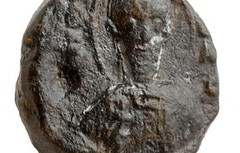 The Antiquities Authority announced Tuesday that it unearthed a rare 800-year-old lead seal from the Monastery of St. Sabas in Jerusalem.
The Antiquities Authority announced Tuesday that it unearthed a rare 800-year-old lead seal from the Monastery of St. Sabas in Jerusalem.
Although the authority said the seal was found over a year ago in the capital’s Bayit Vagan neighborhood, it was only after recent processing and analysis that it officially authenticated the rare relic.
According to the excavation’s directors on behalf of the Antiquities Authority, Benyamin Storchan and Dr. Benyamin Dolinka, the discovery is unprecedented.
“This is an extraordinarily rare find because no such seal has ever been discovered to date,” the archeologists said in a joint statement. “Also, the object possibly contributes important historical information about the surroundings of the site in the Bayit Vagan neighborhood.”
The seal shows a bearded bust of a saint wearing a himation, while holding a cross in his right hand and the Gospel in his left. Surrounding it is a Greek inscription naming him “Saint Sabas.”
On the back of the seal there is a longer Greek inscription, reading: “This is the seal of the Laura of the Holy Sabas.”
To read the complete article, see: Rare Crusade-era seal found in Jerusalem (www.jpost.com/National-News/Rare-Crusade-era-seal-found-in-Jerusalem-354478)
BALDWIN'S SUMMER 2014 ARGENTUM AUCTION
Lot 382 The Princess Louise Medal
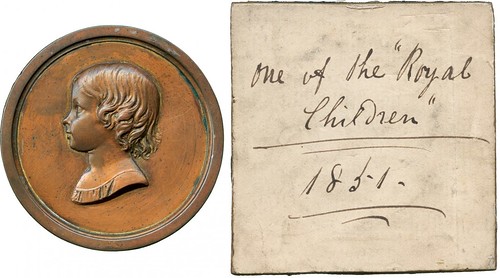
COMMEMORATIVE MEDALS, BRITISH HISTORICAL MEDALS The Princess Louise (1848-1939), uniface Bronzed Electrotype Medal, her bust left, without legend, 56mm (cf BHM 2390; Attwod fig 39, the original wax). Very fine. The Princess Louise was the sixth child and fourth daughter of Queen Victoria. L C Wyon was commissioned to make medallic portraits of all seven of Queen Victoria’s children which, when struck, were 32mm in diameter. This piece is taken directly from the original wax model on slate (now in the British Museum) and may have been intended to be worked over by the reducing machine as part of the preparation of the obverse die. It is mounted on a velvet lined square card on the back of which is written (in Wyon’s hand?), “One of the ‘Royal Children’ 1851”. For further details see Philip Attwood, “A Group of Drawings by Leonard Wyon”, The Medal, No 31, 1997. £100-150
To read the complete lot description, see: Lot 382 (www.sixbid.com/browse.html?auction=1372&category=28188&lot=1259294)
Lot 395 Trial of the Pyx Medal
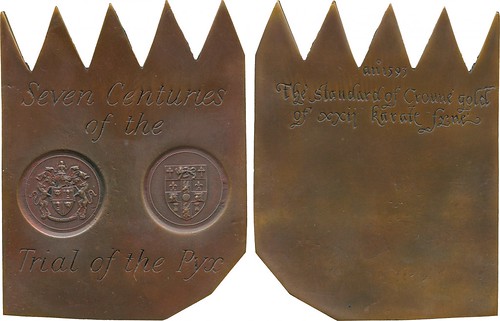
COMMEMORATIVE MEDALS, BRITISH HISTORICAL MEDALS Seven Centuries of the Trial of the Pyx, Cast Bronze Plate, 1982, by the Royal Mint, a copy of the Elizabethan gold plate of 1593, 88mm x 67mm, in case of issue with certificate. As made, extremely fine and very rare. These Pyx plate replicas were presented to those attending the celebratory luncheon at Goldsmiths’ Hall following the delivery of the verdict of the jury on 7 May 1982. £60-80
To read the complete lot description, see: Lot 395 (www.sixbid.com/browse.html?auction=1372&category=28188&lot=1259307)
Lot 406 Beekeepers Association medal

COMMEMORATIVE MEDALS, AGRICULTURAL MEDALS Surrey, Beekeeping, Surrey Beekeepers Association, Bronze Prize Medals (2), to Miss Unwin for Honey, 1920 and 1922, hive, rev inscription in wreath, 45mm; with British Beekeepers Association Bronze Award of Merit Medal, unnamed, bee, rev text in wreath, 40m m, in cases of issue. Extremely fine. ( 3) £30-50
To read the complete lot description, see: Lot 406 (www.sixbid.com/browse.html?auction=1372&category=28189&lot=1259318)
MORE ON BANKNOTES FOR THE VISUALLY IMPAIRED
I got interested in the statement that
"Of the 180 countries that issue banknotes, only 23 use tactile markings such as raised dots, grooves or symbols"
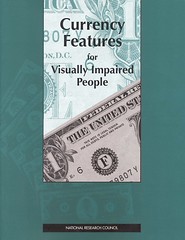 I found an old 1995 document on "Currency Features for Visually Impaired People".
which listed in Appendix D table D-1 (pages 106-112)
the names of 16 countries in 171 listed.
Argentina, Armenia, Aruba, Austria, Belgium, Bulgaria, China, Croatia, Czech Republic,
England, Israel, Namibia, Netherlands Antilles, South Africa, Switzerland, Uruguay
and 7 countries which had on some denominations
Colombia, Cyprus, Germany, Malaysia, Morocco, Netherlands, Peru.
I found an old 1995 document on "Currency Features for Visually Impaired People".
which listed in Appendix D table D-1 (pages 106-112)
the names of 16 countries in 171 listed.
Argentina, Armenia, Aruba, Austria, Belgium, Bulgaria, China, Croatia, Czech Republic,
England, Israel, Namibia, Netherlands Antilles, South Africa, Switzerland, Uruguay
and 7 countries which had on some denominations
Colombia, Cyprus, Germany, Malaysia, Morocco, Netherlands, Peru.
That Totals exactly 23 in 1994 but Belgium, Netherlands and Germany now use a common Euro currency on which I did not see tactile features. So that leaves 20. Sri Lanka currency got such dots in an issue dated 2010 and I wondering what are the other 2 progressive countries over 20 years, or are there more.
To read the complete article, see: Currency Features for Visually Impaired People (www.nap.edu/openbook.php?record_id=4828&page=R1)
I also found this blog entry by a graphic designer:
Over the weekend I was reading a review copy of Eric Karjaluoto’s new book, The Design Method. There’s a page where he mentions how Canadian banknotes are printed with a tactile feature in the corner so the visually impaired can easily tell what denomination they’re holding.
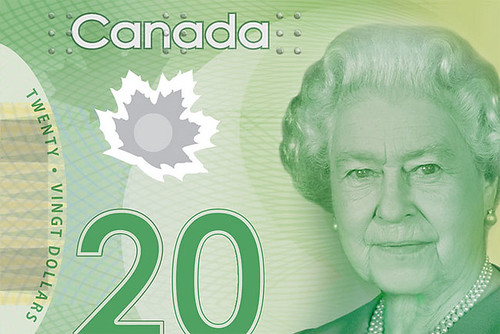
The article linked to an applet from www.looktel.com .
See these YouTube videos:
LookTel Money Reader iPhone app - real time object recognition
(/www.youtube.com/watch?v=lvfDnGMPrkI)
LookTel Money Reader 2.0 iPhone app
(www.youtube.com/watch?v=_HMVXEZNeNM)
But I really liked the comment, "why would a blind person use a touchscreen phone?" which justifies existence of Smart Phones which are NOT touchscreen, for the Blind and persons like me, who don't like touchscreens.
To read the complete article, see: Banknotes for the visually impaired (www.davidairey.com/banknotes-for-the-visually-impaired/)
To read the earlier E-Sylum article, see: CAMPAIGN FOR TACTILE AUSTRALIAN BANKNOTES (www.coinbooks.org/esylum_v17n22a23.html)
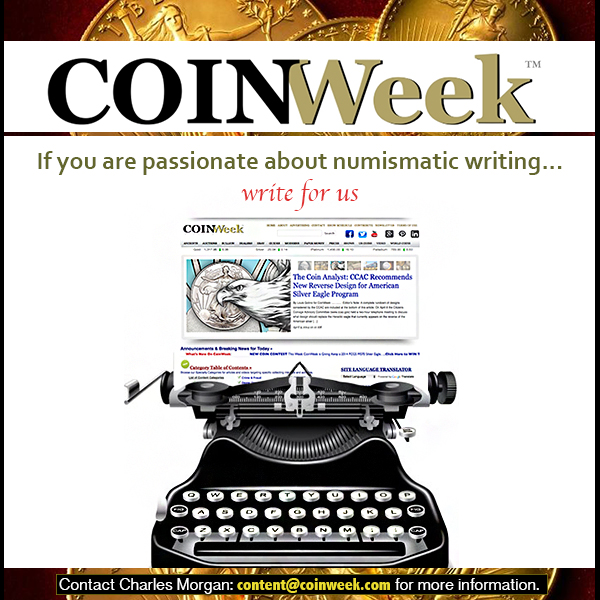
THE 1984 MALTESE ZEKKINI BANKNOTE MYSTERY
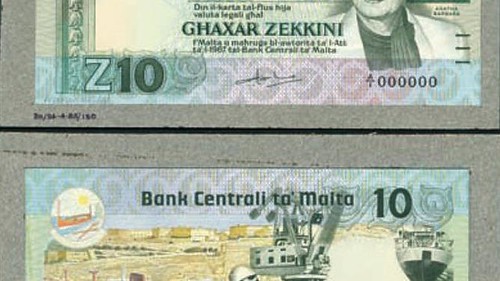
Eyebrows were raised recently, and questions were asked, recently over whether Malta had been considering changing its currency from Maltese liri to Maltese zekkini, after two 1984 Maltese zekkini banknotes (a Z2 and a Z10) went under the hammer in London last month at Spink & Son’s auction house.
The auction house issued a catalogue to promote its auction of banknotes which included designs for a 10 Maltese zekkini and a two Maltese zekkini banknote.
The seller was de la Rue, one of the world’s largest, if not the largest, printers of banknotes. The Z10 note had an estimated price of between £800 and £1,000 and the Z2 note was estimated at between £700 and £900.
But had former Prime Minister Dom Mintoff actually contemplated changing the Maltese currency to zekkini? The answer, according to the Central Bank of Malta, is a definite “No”.
According to the Central Bank, the zekkini notes and most of the other CBM note illustrations in the Spink catalogue are simply token notes with fanciful designs that were created by private individuals or entities, none of which had any association with the Central Bank of Malta.
Speaking to this newspaper about the monetary curiosity, Central Bank Governor Josef Bonnici explained that the only change that had occurred in the 1980s with regard to the denomination was that the word ‘pound’ had been dropped from the Fourth Series of the CBM notes launched in 1986, in contrast to the Second and Third Series notes which included both ‘lira’ (on the front) and ‘pound’ (on the back).
The zekkino concept was derived from the Venetian zecchino, which was also a Maltese gold coin that had been in circulation in Malta in the 18th century.
The uncirculated bogus currency notes put up for auction also included a portrait of then President of the Republic Agatha Barbara that had never made it to any Maltese banknote.
The catalogue states that the Central Bank of Malta note, with serial number A/1000000, bears a signature at the lower centre, is green on multi-coloured under print, includes a portrait of President Barbara on the right, a sailing ship and map at the upper centre, a dove at the upper left, a reverse ship in harbour and a gondola, a shipbuilding worker and crane, and a ship in dry dock. The value of currency is ‘Z10’.
When contacted, Karmenu Mifsud Bonnici, who was appointed Prime Minister in 1984, said he knew nothing about the currency. Former Labour Finance Minister Lino Spiteri suggested to this newspaper that it may have been more of a case of someone toying with the design of Malta’s currency, in line with Prof Bonnici’s explanation. Former Central Bank governor Henry Degabriele had no clue about the banknote, either.
To read the complete article, see: The 1984 zekkini banknote mystery: did Mintoff want to change Malta's currency? (www.independent.com.mt/articles/2014-05-29/news/the-1984-maltese-zekkini-banknote-mystery-5151195137/)
1820 NORTH WEST COMPANY TOKEN
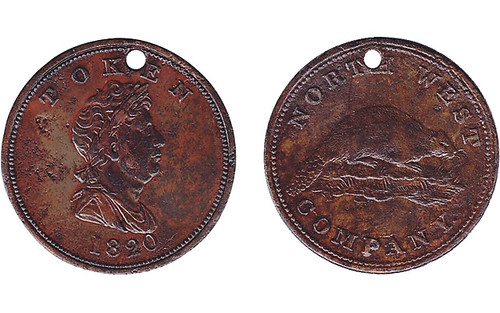
A rare token from the history of North American exploration and commercialization highlights Geoffrey Bell Auctions’ May 29 and 30 sale in Toronto.
The North West Company token, a rarity in brass (most are found in copper), is probably the finest known example, and certainly the best example ever handled by the auction firm, according to Brian Bell, the firm’s president.
The North West Company was a competitor of the more famous Hudson Bay Company.
The North West Company was formed around 1779 in Montreal. Early leaders were the Frobisher brothers, Simon McTavish, Peter McGill, and 16 other investors and agents, holding 20 shares in all. The agents were the individuals who spent the fur trading season in fur country overseeing trade with the aboriginal peoples.
The Hudson and North West companies merged in 1821 but not before numerous minor skirmishes, culminating in the Battle of Seven Oaks, between traders for the two companies.
The tokens were made in Birmingham, England, by John Walker & Co., for use promoting the fur-trapping enterprise in the Pacific Northwest. Tokens were reportedly good for one beaver pelt (which explains the beaver shown on the reverse).
Most of the surviving tokens of the North West Company have been unearthed in the lower Columbia River valley. The aboriginal tribes of that area had a practice of burying a deceased person’s belongings with the body. Many of the extant tokens found today are corroded as a result, having been underground for lengthy periods of time.
To read the complete article, see: Rare North West Company token in brass highlights Geoffrey Bell Auctions’ Toronto sale (www.coinworld.com/insights/rare-token-highlights-geoffrey-bell-auctions--toronto-sale.all.html)
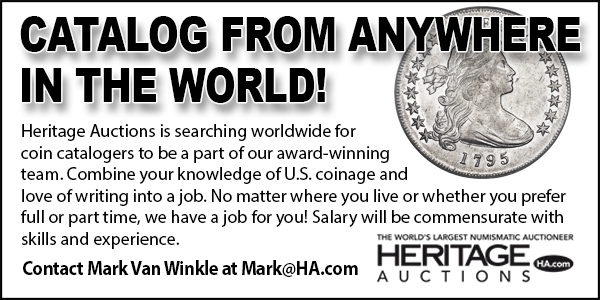
1879 CHILE EMISSION COLECTIVA 20 CENTAVOS NOTE
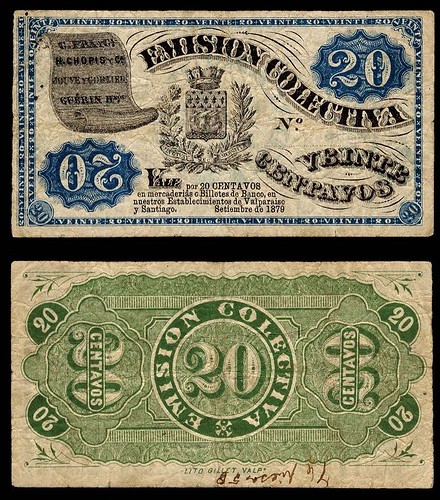
115 x 67mm. According to Leon Burstyn, well known and active years ago in Latin American numismatics, this is a very difficult issue made during the War of the Pacific (1879-83). Countries involved were Chile against Bolivia and Peru. The war resulted in Chilean annexation of valuable disputed territory on the Pacific coast. This note bears names of four companies that agreed to back the issue. Face is bright blue; back green with some writing at lower right center.
To read the complete lot description, see: NL 20 Centavos September 1879 (www.lynknight.com/ShowAuctionDetails.Asp?auction_Id=224900)
PANAMA RAIL ROAD CO. ONE DOLLAR NOTE

115 x 41mm. The Panama Rail Road Co. was a strong factor in the development of the canal beginning in 1907. John F. Stevens was heavily involved with the beginning of the canal project. His printed signature appears on the back of this 1 Dollar commissary note. Judging by wording on the piece, it was issued as part of a book of notes; I have never seen such a book or any other example of this $1 before. As little paper money from Panama is available, this great display item should engender considerable bidding. Fully original, signs of use but overall very attractive and of obvious rarity.
To read the complete auction lot description, see: NL 1 Dollar ND (ca. 1906) (www.lynknight.com/ShowAuctionDetails.Asp?auction_Id=224896)
1944 OLIVETTI COMPANY 100 LIRE NOTE

177 x 110 mm. Rare discovery piece; the only privately issued note I have ever seen or heard of used in northern Italy right during heavy fighting of World War II! There were a number of bank assegni made in 1944 but nothing like this piece. Made and issued in Ivrea by the famous Olivetti Company, so well known for its typewriters and calculators, later computers.
To read the complete auction lot description, see: NL 100 Lire 7.11.1944 (www.lynknight.com/ShowAuctionDetails.Asp?auction_Id=228874)
WILKES & CURTIS AUCTION #01 CLOSES JUNE 16, 2014
Fresh to the numismatic market, a collection of coins of Morocco will join more than 500 lots of Islamic, Indian, and world coins and medals in the inaugural online-only auction for newly established numismatic auction house, Wilkes & Curtis, on Monday 16th June.
Tim Wilkes of Wilkes & Curtis said: “Our first auction is truly international but, like the Wilkes & Curtis brand, has a strong focus on coins from both the Indian and Islamic worlds. These coins give both the seasoned collector and those new to the subject of numismatics a fascinating insight into the role coinage has played in the culture and politics of the world.”
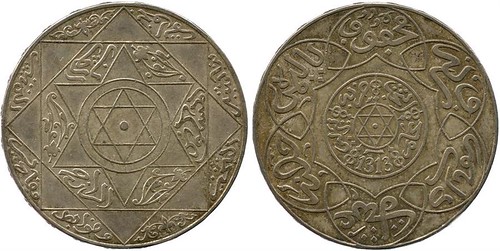
The selection of 75 lots from Morocco is highlighted by a silver 10-Dirham coin of ‘Abd al-‘Aziz, minted in Berlin in 1313h (1895-1896 AD). The 10-Dirham coin dates from a period when an independent Morocco had, invited European intervention to help the fragile sovereign state protect threatened investments, and to help Morocco push for economic allowances. Diplomatic manipulation saw the European states, France in particular, rush to extend their interests in North Africa, and it is therefore unsurprising that Moroccan coins from this period were minted not only in Fes, but also in Berlin, Paris, Birmingham, and London. This extremely fine example is estimated to sell for £400–500. [Lot 33]
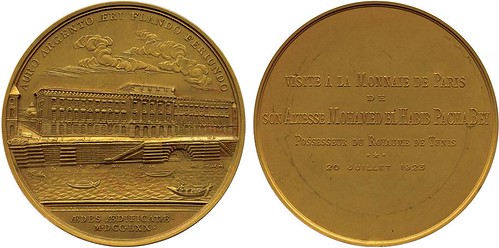
An extremely rare gold medal, believed to have been presented to Tunisian ruler Muhammad al-Habib Bey during his 1923 visit to the Paris Mint, is representative of French influence in North Africa at the time. Containing over 175 grams of gold, this medal would only have been gifted to a person of very high rank and is believed to be unique, having been produced specifically to commemorate the visit of Pacha Bey, and presumably presented to him personally as a souvenir.
The finely impressed obverse is struck from the reverse die originally engraved by French engraver and medallist, Charles Norbert Roettiers. A member of the notable Roettiers family of medallists and goldsmiths, Charles Norbert worked as engraver-general at the French mint between 1753 and 1772. The original die was created in 1770 for a medal to commemorate the construction of the neoclassical edifice, the Hôtel des Monnaies, which has, since it was constructed between 1767 and 1775, housed the Monnaie de Paris, or the Paris Mint.
This medal of the highest rarity comes with a solid provenance, and is estimated to sell for £14,000 – 16,000. [Lot 238]
Bidders will have the opportunity to bid for all 579 lots online, by email, or by post, and printed catalogues are available on request. The catalogue can be viewed, and bids submitted, online at auctions.wilkesandcurtis.com and the auction will close on Monday 16th June.
Wilkes & Curtis Ltd
PO Box 566
Tonbridge, Kent
TN9 9LR
+44 (0) 7535 383 321
wilkesandcurtis.com
PRESIDENTIAL EXONUMIA SALE #84 CLOSES JUNE 20, 2014
 Our 84th Sale is our first sale in many years without a live component. We have attempted to set new bidding rules which are fair to all. For the first time in a long time, bidders, who in the past were unable to effect a live presence, will not be at a competitive disadvantage. We are, however, willing to learn and if you have ideas as to how we can make improvements, we are all ears!
Our 84th Sale is our first sale in many years without a live component. We have attempted to set new bidding rules which are fair to all. For the first time in a long time, bidders, who in the past were unable to effect a live presence, will not be at a competitive disadvantage. We are, however, willing to learn and if you have ideas as to how we can make improvements, we are all ears!
Auction 84 starts out with a fine offering of Hard Times Tokens. It is highlighted by the extremely rare storecard of Walton, Walker & Co. of New Orleans (Low 106; HT 129) Ours is only the seventh known specimen of this token, an example of which was last sold in the Dice/Hicks Sale of 2008 for $63,250.00! Speaking of the Dice/Hicks Collection, we have from their sale the only known example of Low 246A, the 6 ¼¢ denomination of the Norristown, Pa. merchant, S. Feather. From the same collection, we have one of the rarest HTT merchant tokens, that of Edwin Parmelee’s Bowling Saloon. In addition to these great rarities, there are many scarce and rare tokens for the collector with more modest means.
Our offering of 19th century merchant tokens includes a significant collection of soda water tokens put together over many years by our friend, Michael Greenspan. Since one of the early uses of “soda water” was for medicinal and health purposes, this collections could also double as a collection of druggist tokens. Michael shares with us the genesis of his interest in the specialty.
“I can still remember, as a child in the 1940’s, that my grandfather owned and operated an old-fashioned candy store in Manhattan. It was a popular gathering place that sold newspapers, cigarettes, fountain drinks and ice cream, among other sundries. There was always a steady stream of customers because the store also contained a pay phone booth at a time when residential phone service was still scarce and expensive. Frequently, there was a long queue of customers waiting to use the phone and many of them ordered an ice cream cone or fountain concoction while they waited.
As a youngster, I was posted at the large window-counter opening to the street to sell loose cigarettes at two for a penny and fountain drinks, either plain carbonated water, (“seltzer”) for two cents each, or flavored drinks for five. If a customer gave me a dime or quarter, I was instructed to return his change in the form of aluminum tokens, which could be used for a subsequent purchase. Over the years, I discovered that this was not an unusual practice and that many merchants issued tokens for this purpose.”
Our offering Civil War Tokens is distinguished by a collection of New Jersey storecards that numbers no less than 23 off-metal varieties! Presidential always has an enviable offering of Political Exonumia and this sale is no different. It begins with an enigmatic oval silver “Washington Guards” portrait piece, probably from the mid 19th century. From the John Ford Collection comes example of AJACK 1828-1 in AU; a rare James Polk Shell token (JP 1844-8) and an unlisted variety of a Lewis Cass shell token.
Our usual fine offering of Presidential Inaugural memorabilia features an extensive offering of Official Inaugural Police badges as well as our usual offering of rare and scarce inaugural medals.
The World’s Fair section is notable for the offering of a Columbian Exposition Award Medal struck in aluminum as well as for an extremely rare German Imperial Plaque for the 1904 Saint Louis World’s Fair.
The section on US Mint medals features a silver Indian Peace Medal struck for President Grant.
As an associated offering, there is an extraordinary large cream colored Copeland pitcher decorated with gilded copies of the obverse and reverse of the Grant Peace Medal on its sides. Other tantalizing lots include a choice example of CM-5, Sansom’s Peace of 1783, Washington and Franklin medal and a Department of Commerce Exceptional Service Medal in gold.
If there is one area for which Presidential has come to be known, it is our offering of art medals by renowned sculptors and medallists. The following sculptors are represented in the remainder of the sale by at least one, and sometimes, by many works:
Herbert Adams. Lea Ahlborn, Robert Aitkin, Chester Beach, Norman Bel Geddes, Edouard Blin, Gutzon Borglum, Victor D. Brenner, Charles Calverley, Gaetano Cecere, John Mowbray Clarke, Eugene Daub, Anthony de Francisci, Donald De Lue, Godefroid Devreese, Avard Fairbanks, John Flanagan, James Earle Fraser, Laura Gardin Fraser, Daniel Chester French, Emil Fuchs, Adlai Hardin, Eli Harvey, Anna Vaughn Hyatt, Marcel Jovine, Julio Kilenyi,, R. Tait McKenzie. Frederick MacMonnies, Paul Manship, Allen G. Newman, Bela Lyon Pratt J. Edouard Roine, Oscar Roty, Augustus Saint-Gaudens, Louis Saint-Gaudens, Anton Scharff, Theodore Spicer Simpson, Jean Vernon and Karen Worth
CANADIAN SPORTS TRADITION: LUCKY COINS
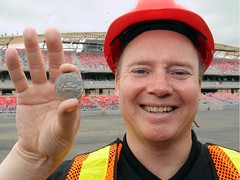 For good luck, the Ottawa Sports and Entertainment Group buried a silver dollar under the turf at the new Lansdowne stadium Thursday, where the Ottawa RedBlacks will play.
For good luck, the Ottawa Sports and Entertainment Group buried a silver dollar under the turf at the new Lansdowne stadium Thursday, where the Ottawa RedBlacks will play.
The dollar is from 1976, the last year an Ottawa CFL team, the Rough Riders, took home the shiny, silver Grey Cup.
Here’s a timeline of how this ritual became a Canadian sports tradition.
2002
A legend is born
In 2002, Canadian ice-makers placed a Canadian dollar coin in centre ice at the Olympic arena in Salt Lake City. Canada went on to win gold in both men’s and women’s hockey. The Loonie was recovered by Wayne Gretzky and brought to the Canadian Hockey Hall of Fame.
2003
Helsinki Loonie
At the 2003 IIHF World Hockey Championships in Helsinki, Finland, Team Canada officials snuck a Canadian dollar into the padding beneath the crossbar of the Swedish net before the Sweden-Canada gold-medal game. Canada won.
2006
Curling coins
In 2006, Brad Gushue won gold on a sheet that had a Loonie buried at either end. In the same Olympics icemakers announced they wouldn’t bury a Loonie for the hockey tournament; the men’s team finished out of the medals, though women won gold.
2010
In the foundation
The architect who designed the curling venue for the 2010 Vancouver Winter Olympics placed three loonies in the floor before concrete was poured. Men took gold in curling, women took silver in curling, and both men and women took the gold in hockey – that’s three gold medals for three Loonies.
2014
Snowy dollar
Canadian Jan Hudac buried a Loonie near the finish line before snagging bronze at the men’s super-G race in Sochi. This made him the first Canadian to win an Olympic medal in alpine skiing in 20 years.
To read the complete article, see: Lucky silver dollar (ottawacitizen.com/news/local-news/lucky-coins)
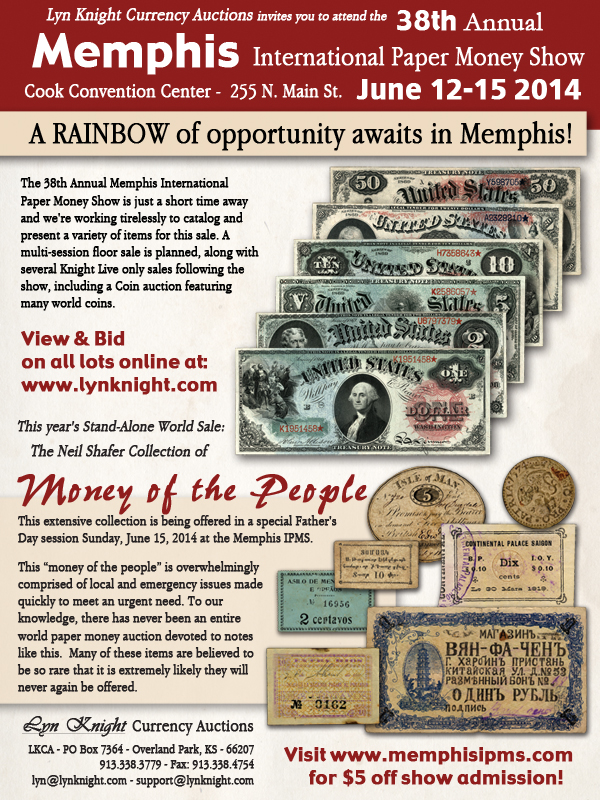
ANA'S TREASURES OF THE DEEP EXHIBIT
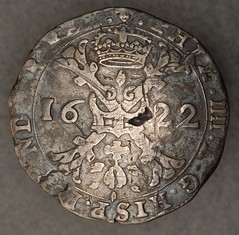 The Edward C. Rochette Money Museum will present a new exhibit, "Treasures of the Deep: Galleons, Storms and Archeology," telling the story of the world's greatest shipwrecks, the treasures they carried and the efforts to preserve the shipwreck sites. The exhibit opens on June 5 with a free Open House.
The Edward C. Rochette Money Museum will present a new exhibit, "Treasures of the Deep: Galleons, Storms and Archeology," telling the story of the world's greatest shipwrecks, the treasures they carried and the efforts to preserve the shipwreck sites. The exhibit opens on June 5 with a free Open House.
"This exhibit focuses not only on the romance of sunken treasure, but also on the exciting process of rediscovering and recovering treasure from the ocean floor," said Douglas Mudd, curator for the Money Museum. "A big part of the story is the science involved in rediscovering these wrecks, which are time capsules that preserve the history of seafaring."
The lure of gold and silver discovered in North America drew settlers from Europe to explore and colonize the New World, changing the economic and political world map in the process. Spain used the bullion discovered to craft ingots and coinage in the form of silver reales and gold escudos. These coins would dominate the world economy for centuries and become legendary for their rich history as pirate gold and lost treasure.
The exhibit will explore adventures on the world's oceans along with artifacts and treasure found in underwater wrecks from the 16th century to the modern day. The history of underwater recovery and archaeology will be highlighted with the help of Odyssey Marine Exploration, one of the largest and most successful underwater recovery organizations. The exhibit highlights the research and technology used to locate long-lost ships and preserve historical artifacts.
See "Treasures of the Deep" during a free opening reception from 5-7 p.m. June 5 at the Money Museum, 818 N. Cascade Ave., in Colorado Springs, Colorado. Visitors can take home a special "Treasures of the Deep" medallette. Complimentary wine and hors d'oeuvres will be served.
The exhibit is sponsored by Daniel Frank Sedwick, LLC, an auctioneer and specialist in shipwreck coins.
The Money Museum hours are 10:30 a.m.-5 p.m. Tuesday through Saturday. Admission is $5 for adults, $4 for seniors, students or military and free for children 12 and under. For more information or to schedule a tour, call 719-632-2646.
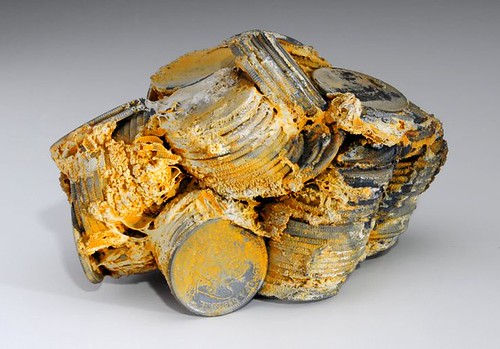
To visit the Pinterest page, see: Treasures of the Deep (www.pinterest.com/anacoins/treasures-of-the-deep/)
To read the complete article, see: Money Museum presents new exhibit: ‘Treasures of the Deep’ (www.money.org/communications/press-releases/archives/2014-press-releases/money-museum-presents-new-exhibit-%E2%80%98treasures-of-the-deep%E2%80%99.aspx)
STACKS-BOWERS OFFERS 1868 HONG KONG PROOF SET
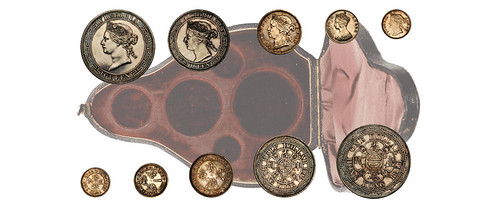
Stack’s Bowers and Ponterio is excited to offer this week’s August 2014 Hong Kong Showcase Auction highlight — a unique 1868 Hong Kong Proof Set, the only complete set known to exist. While unique as a complete set, on an individual basis every coin present is a great rarity. The 5 Cents, 10 Cents and Dollar were unknown to both Pridmore and Remick (two of the leading authors in this field). In fact, the 5 Cents and 10 Cents were totally unpublished and reportedly unknown as proofs prior to the discovery of this set.
In researching the Irving Goodman, Jerry Remick, Fred Pridmore, Diana, and Dragon Collection, the only record for any denomination of 1868 Proof coinage appeared in Superior’s 1995 auction of the Irving Goodman collection that contained a 50 Cent 1868 Proof which sold for $109,250. Prior to the discovery of this set, the Goodman collection noted “possibly only one other 1868 50 Cent exists in a museum,” thus suggesting only two examples are known in private hands.
This unique 1868 Hong Kong proof set first became known to the numismatic community when it appeared in Spink’s Auction #7023 (Lot #236, September 27, 2007). Prior to this, the set was completely unpublished and remained unknown to numismatic scholars. It was originally acquired in the course of doing business in Hong Kong and remained in the same family for more than 100 years.
Authorization to establish the mint in Hong Kong was granted by England on April 10, 1863 and production began May 7, 1866. The mint in Hong Kong served as a colonial branch of the British Royal Mint; however, the operation proved to be a financial failure and shut down in April of 1868. After this closure, the machinery was sold to the Osaka Mint in Japan. The 1866-68 coinage is highly important, as it represents the first modern machine struck coinage actually produced in Hong Kong. Subsequent Hong Kong issues were produced in England, with the large majority being produced by the Heaton Mint at Birmingham.
To read the complete article, see:
The Only 1868 Hong Kong Proof Set Known to Exist
(www.stacksbowers.com/NewsMedia/Blogs/TabId/780
/ArtMID/2678/ArticleID/64542/The-Only-1868-Hong-Kong-Proof
-Set-Known-to-Exist.aspx)
EMPEROR NORTON'S BRIDGE
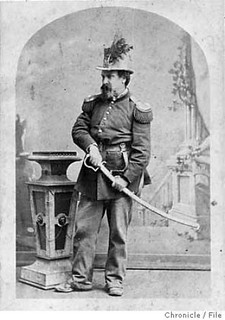 Joshua Abraham Norton -- who, according to his Chronicle obituary, hailed from Scotland -- was a businessman who came to San Francisco by way of South Africa in 1849 to try his luck in the Gold Rush. It is said that he lost his fortune -- and his mental stability -- after making a bum investment in the rice market a few years later.
Joshua Abraham Norton -- who, according to his Chronicle obituary, hailed from Scotland -- was a businessman who came to San Francisco by way of South Africa in 1849 to try his luck in the Gold Rush. It is said that he lost his fortune -- and his mental stability -- after making a bum investment in the rice market a few years later.
In 1859, he proclaimed himself Emperor of the United States and, shortly thereafter, the Protector of Mexico. For the next 20 years, he issued proclamations defending minorities and championing civil rights, which were reproduced in local newspapers. He roamed the city accompanied by his dogs, Bummer and Lazarus, and some eateries honored Norton's own specially printed paper money.
In 1872, Norton ordered "a bridge be built from Oakland Point to Goat (Yerba Buena) Island and thence to Telegraph Hill." Though his proclamation received little notice at the time, such a bridge would open in 1936, described by President Herbert Hoover as "the greatest bridge ever erected by the human race."
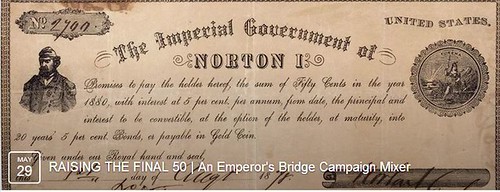
To help carry forward our call for the State of California to name the San Francisco-Oakland Bay Bridge for Emperor Norton, THE EMPEROR'S BRIDGE CAMPAIGN has been laying the groundwork to incorporate as a 501(c)(4) nonprofit membership organization.
EMPEROR NORTON'S BOOZELAND MAKING "CAMPAIGN DONATION" OF $2 A DRINK FROM THURSDAY NIGHT SALES OF DRINKS FEATURING HANDMADE ABSINTHES AND GINS FROM LOCAL RAFF DISTILLERIE
Our fundraiser on Thursday is at Emperor Norton's Boozeland — a longtime friend of the Campaign and the site of our launch party last September. Amongst the featured liquors at Boozeland are two spirits — Emperor Norton Absinthe Dieu and Bummer & Lazarus Gin — handmade on Treasure Island by another friend of the Campaign, Raff Distillerie.
At Boozeland...
+ Emperor Norton Absinthe cocktail (simple syrup, water & ice) >>> $10
+ Bummer and Lazarus Gin & Tonic >>> $8
For every one of these you buy on Thursday night, Boozeland will donate $2 to The Emperor's Bridge Campaign. Thanks, Boozeland!
"The idea of holding a fundraising gala for such a small amount is nicely daft and a neat counterpoint to the big money campaign mixers in political circles."
To read the complete Facebook page, see: RAISING THE FINAL 50 | An Emperor's Bridge Campaign Mixer (www.facebook.com/events/1596338297258151/)
FEATURED WEB SITE: HOBO NICKEL ART
This week's Featured Web Site is Hobo Nickel Art, a compendium of classic and modern Hobo nickels from around the web.Hobo nickels are one of the great American folk art forms. Engraving designs into coins has been a part of American culture since the 1700s.
Coin carving took on a new life as the Great Depression took its toll on America in the early 20th century. With so many Americans out of work, both fledgling and experienced artists embellished nickels in order to survive. These “hobo nickels” were often used to pay for food and lodging.
The art that was created at this time was imaginative and represented an important time in America’s history.
After the Depression, many talented artists continued perfecting their craft which is still practiced today.
Hobo Nickel Art is a blog with a purpose to chronicle and compile hobo nickels found online. We will link to Hobo Nickel related websites, artists and items for sale on various web destinations such as eBay.
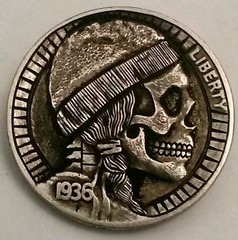
www.hobonickelart.com

